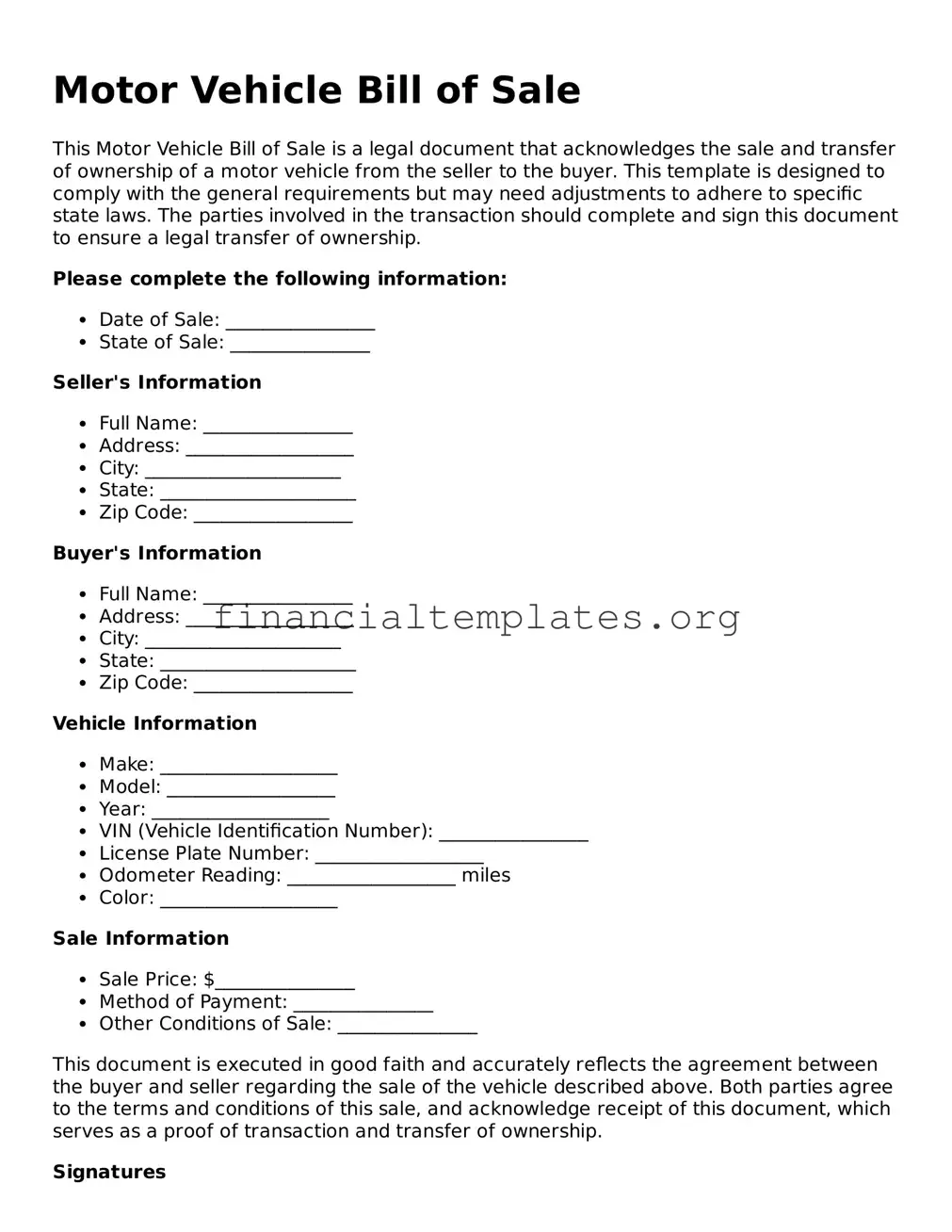The Warranty Deed shares similarities with the Motor Vehicle Bill of Sale as it serves as a formal document used in real estate transactions. This deed not only transfers ownership of property from one party to another but also guarantees that the property is free from any liens or claims. Much like how a Bill of Sale assures the buyer of a vehicle's ownership status without encumbrances, a Warranty Deed offers peace of mind to the purchaser with a guarantee about the property's clear title.
Similarly, a Promissory Note is often paralleled with a Motor Vehicle Bill of Sale, albeit in the realm of financial transactions. This document outlines the terms under which one party promises to pay a certain sum to another. It is akin to a Bill of Sale in that it formalizes an agreement between parties and sets forth the conditions of the transaction, ensuring that the obligations of both parties are clearly understood and legally binding.
The Quitclaim Deed, much like the Motor Vehicle Bill of Sale, is utilized for transferring interest in property. However, unlike the Warranty Deed, it does not guarantee that the title is clear. This means that while both documents serve the purpose of transferring ownership rights, the Quitclaim Deed does so without any assurance against liens or encumbrances. This is akin to a Bill of Sale that simply records the sale of an item without claims to its condition or legal status.
An Equipment Bill of Sale also shares characteristics with the Motor Vehicle Bill of Sale, as it is used to transfer ownership of personal property other than vehicles, such as machinery or office equipment. This document outlines the details of the transaction, including the condition and description of the equipment, ensuring a clear understanding between buyer and seller. It mirrors the structure and intent of a Motor Vehicle Bill of Sale, catering to a specific category of assets.
The General Bill of Sale is akin to the Motor Vehicle Bill of Sale, functioning as a broad document for the sale of various items not specifically categorized. It records the transfer of ownership of goods from one individual to another, offering proof of the transaction. This versatility makes it similar to a Motor Vehicle Bill of Sale but without the specific focus on vehicles, making it applicable to a wider range of items.
As for the Rental Agreement, it resembles the Motor Vehicle Bill of Sale in its role as a legally binding document between two parties. However, it concerns the lease or rental of property, vehicles, or equipment rather than the outright sale. Both documents outline terms agreed upon by the parties involved, such as payment and conditions of use, establishing clear and enforceable rights and responsibilities.
The Receipt Acknowledgment is another document related to the Motor Vehicle Bill of Sale, as both serve as proof of a transaction. A Receipt Acknowledgment confirms that a payment has been made and received, similar to how a Bill of Sale verifies the sale and transfer of ownership of a vehicle. It’s a crucial piece for validating that obligations have been fulfilled by both parties in a sale.
A Certificate of Title, especially for vehicles, is intrinsically connected to the Motor Vehicle Bill of Sale since it officially records the owner of the vehicle in governmental records. While the Bill of Sale acts as evidence of the transaction, the Certificate of Title is the legal document that establishes and recognizes the vehicle's ownership. Both are essential in the sale and purchase process, ensuring that ownership is both transferred and recorded with the relevant authorities.
Loan Agreements also have much in common with the Motor Vehicle Bill of Sale, focusing on the terms under which one party lends money to another. These documents stipulate repayment conditions, interest rates, and collateral, which might include vehicles. In this way, a Loan Agreement ensures a clear understanding and legal commitment regarding the borrowing and repayment of funds, paralleling how a Bill of Sale secures the terms of a sale.
Last but not least, the Sales Agreement, like the Motor Vehicle Bill of Sale, details the sale of goods between two parties. This document can apply to various types of items, including vehicles, ensuring that aspects such as payment terms, delivery details, and warranties are clearly laid out. While a Motor Vehicle Bill of Sale specifically documents the transaction of a vehicle, a Sales Agreement covers a broader scope of sales transactions, making it a versatile counterpart.
